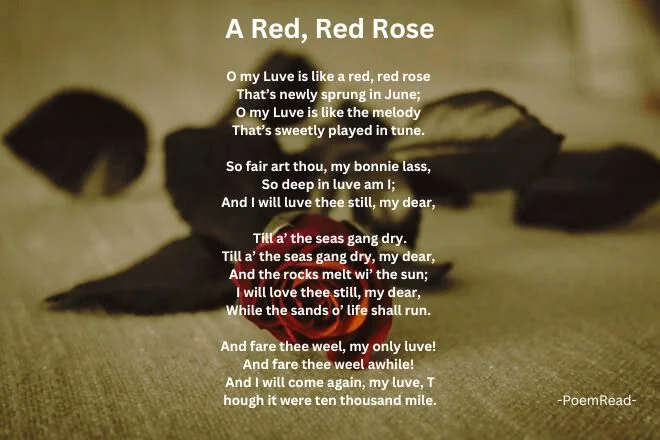
Welcome to a journey through the romantic verses of “A Red, Red Rose” by Robert Burns, a poem that has captivated hearts since the 18th century. This lyrical masterpiece is not just a declaration of deep love but also a testament to the enduring nature of affection that transcends time and space. Let’s examine the literary aspects of this exceptional poem.
A Red, Red Rose BY ROBERT BURNS O my Luve is like a red, red rose That’s newly sprung in June; O my Luve is like the melody That’s sweetly played in tune. So fair art thou, my bonnie lass, So deep in luve am I; And I will luve thee still, my dear, Till a’ the seas gang dry. Till a’ the seas gang dry, my dear, And the rocks melt wi’ the sun; I will love thee still, my dear, While the sands o’ life shall run. And fare thee weel, my only luve! And fare thee weel awhile! And I will come again, my luve, Though it were ten thousand mile.
Content
- About the Author: Robert Burns
- Subject of "A Red, Red Rose"
- Context of "A Red, Red Rose"
- Theme and Tone of "A Red, Red Rose"
- Form and Structure of "A Red, Red Rose"
- Line-by-line Analysis of "A Red, Red Rose"
- Poetic and Literary Devices in "A Red, Red Rose" by Robert Burns
- The implications and meanings of Robert Burns' poem "A Red, Red Rose"
- Interactive Summary of "A Red, Red Rose"
About the Author: Robert Burns
Robert Burns,Scotland’s national bard , was born on January 25, 1759, in Alloway, Scotland. His upbringing in a culturally rich environment shaped his writing style, which often delves into themes of love, nature, and societal issues. Despite starting as a farmer, Burns displayed exceptional talent in poetry from a young age, crafting verses that resonated with raw emotion.
His renowned poem “A Red, Red Rose” showcases his lyrical prowess and ability to evoke profound feelings through vivid imagery. Burns wrote in both Scots and English, highlighting his versatility and dedication to preserving Scottish culture. He used his poetry as a platform to address social injustices, earning him a reputation as a voice for the common people.
Despite his early death at 37, Burns’ legacy as Scotland’s national poet endures, celebrated annually on Burns Night, where people honor his contributions to literature and culture.
Subject of “A Red, Red Rose”
Love and Beauty as Central Themes
The subject of love and beauty is a common theme in poetry, and “A Red, Red Rose” is no exception. In this poem, the speaker uses vivid and evocative language to convey their deep affection for their beloved.
The comparison of the speaker’s love to a freshly bloomed red rose is a powerful image that symbolizes the intensity and passion of their emotions. Just as a rose is vibrant and beautiful, so too is the love that the speaker feels.
Musical Imagery: Love as a Harmonious Melody
The poem also employs musical imagery, likening the speaker’s love to a sweet melody played in perfect harmony. This comparison adds depth by suggesting that the love shared is not only visually beautiful but also harmonious and melodious. The use of musical imagery enhances the theme of love and beauty, emphasizing emotional resonance and harmony.
Enduring Commitment and Devotion
Moreover, “A Red, Red Rose” celebrates the enduring nature of love. The speaker’s declaration to love their beloved until the seas run dry and the rocks melt with the sun conveys a sense of eternal commitment and devotion. This imagery of the vastness and permanence of the natural world serves to emphasize the timelessness of love. It suggests that love, like the seas and the rocks, is an unchanging force that transcends the boundaries of time and space.
In essence, “A Red, Red Rose” is a heartfelt exploration of love and beauty. Through its vivid imagery and powerful language, the poem captures the intensity and depth of the speaker’s affection for their beloved. The comparison to a red rose and a sweet melody adds richness and depth to the poem, while the imagery of the seas and the rocks conveys the enduring nature of love. Ultimately, this poem serves as a testament to the transformative power of love and its ability to inspire and uplift the human spirit.
Context of “A Red, Red Rose”
Romanticism’s Influence
Written during the Romantic era, “A Red, Red Rose” embodies many of the characteristics associated with this literary movement. Romanticism emphasized the importance of emotions, individuality, and the sublime in art and literature. Burns’ poem, with its passionate expression of love and its focus on the beauty of nature, aligns perfectly with the ideals of Romanticism.
Scottish Folklore and Cultural Heritage
In addition to the influence of Romanticism, the poem also draws inspiration from Scottish folklore and traditional ballads. Burns often incorporated elements of Scottish culture and folklore into his works, adding a unique and distinct flavor to his poetry. This infusion of Scottish heritage adds depth and richness to the poem, making it a true reflection of Burns’ cultural identity.
Scottish folklore, with its tales of mythical creatures, heroic deeds, and supernatural occurrences, provided Burns with a rich tapestry of stories and symbols to draw upon. In “A Red, Red Rose,” the speaker’s love is compared to a rose that is “newly sprung in June,” a symbol of beauty and freshness. This imagery not only evokes the natural world but also taps into the tradition of using flowers as symbols of love and desire in Scottish folklore.
Language and Dialect
Furthermore, the poem’s use of language and dialect reflects Burns’ deep connection to his Scottish roots. The Scottish dialect, with its distinct pronunciation and vocabulary, adds an authentic and intimate quality to the poem. It transports the reader to the rugged landscapes of Scotland and immerses them in the cultural heritage of the country.
Blend of Themes and Symbolism
Moreover, the theme of love in “A Red, Red Rose” is not only influenced by Romantic ideals but also by the Scottish tradition of love songs and ballads. Burns was known for his skill in writing songs and his ability to capture the complexities of human emotions. In this poem, he explores the depths of love and its enduring nature, drawing on the tradition of Scottish ballads that often portray love as a powerful force that transcends time and distance.
In summary, “A Red, Red Rose” is a masterful blend of Romanticism and Scottish folklore. It showcases Burns’ ability to infuse his poetry with deep emotion, vivid imagery, and a strong sense of cultural identity. Through his use of language, symbolism, and themes, Burns creates a poem that resonates with readers on both an intellectual and emotional level, leaving a lasting impression of love and beauty.
Theme and Tone of “A Red, Red Rose”
Theme of “A Red, Red Rose”
The central theme of “A Red, Red Rose” is the everlasting nature of love. The poem explores the idea that true love transcends time and remains constant, even in the face of life’s challenges and uncertainties. The speaker’s deep affection for their beloved is portrayed as an unbreakable bond that will endure until the end of time.
The poem begins with the speaker comparing their love to a “red, red rose.” This vivid imagery suggests the beauty and vibrancy of their feelings. The use of the color red also symbolizes passion and intensity, further emphasizing the depth of the speaker’s emotions. By comparing their love to a rose, the speaker suggests that their affection is not only timeless but also delicate and fragile.
Throughout the poem, the speaker expresses their unwavering devotion to their beloved. They promise to love them “till a’ the seas gang dry” and “till the rocks melt wi’ the sun.” These hyperbolic statements serve to emphasize the speaker’s commitment and dedication. They are willing to endure any hardship or obstacle in order to remain faithful to their love.
Tone of “A Red, Red Rose”
The tone of the poem is tender, passionate, and filled with longing. The speaker’s words are infused with emotion, conveying the intensity of their love. The use of vivid imagery and romantic language enhances the overall tone, creating a sense of enchantment and beauty.
Furthermore, the poem’s structure and rhythm contribute to its tone. The poem is written in four quatrains, with each stanza following an AABB rhyme scheme. This regularity and symmetry create a sense of harmony and balance, mirroring the stability and constancy of the speaker’s love. The poem’s meter is primarily iambic tetrameter, which gives it a musical quality and a gentle, flowing rhythm. This rhythm adds to the poem’s tender and heartfelt tone.
To sum up, “A Red, Red Rose” explores the timeless beauty of love. The poem’s central theme emphasizes the enduring nature of true love, while its tone conveys the depth of the speaker’s emotions. Through vivid imagery, romantic language, and a carefully crafted structure, the poem captures the essence of love’s everlasting power.
Form and Structure of “A Red, Red Rose”

Structure and Rhyme Scheme
“A Red, Red Rose” is a lyric poem composed of four stanzas, each containing four lines. The poem follows a consistent rhyme scheme of ABAB, with the second and fourth lines of each stanza rhyming. This regular and rhythmic pattern adds to the musicality of the poem, reinforcing the comparison of love to a sweetly played melody.
Furthermore, the poem’s structure reflects the speaker’s unwavering devotion to their beloved. The repetition of the ABAB rhyme scheme throughout the stanzas creates a sense of stability and consistency, mirroring the enduring nature of true love. The consistent rhyme scheme also adds a sense of harmony and balance to the poem, further emphasizing the speaker’s deep affection.
Flow of the poem
Moreover, the absence of pauses or line breaks within the stanzas allows the poem to flow seamlessly from one line to the next. This uninterrupted flow contributes to the overall sense of harmony and unity within the poem, mirroring the unbroken connection between the speaker and their beloved. The lack of breaks also suggests an unending love, symbolizing the eternal nature of their bond.
Punctuations
In terms of punctuation, Burns uses minimal punctuation in “A Red, Red Rose.” This deliberate choice allows the words to flow naturally and maintains the lyrical quality of the poem. The absence of excessive punctuation adds to the simplicity and elegance of the verses, allowing the reader to focus solely on the beauty of the language and the depth of emotion conveyed.
Overall, the form and structure of “A Red, Red Rose” contribute to its timeless appeal. The consistent rhyme scheme, seamless flow, and minimal punctuation all work together to create a poem that is both musically pleasing and emotionally resonant. Through its carefully crafted structure, the poem captures the essence of love and the enduring power of human connection, making it a beloved piece of literature that continues to move readers to this day.
Line-by-line Analysis of “A Red, Red Rose”
Love as a Vibrant Symbol: “O my Luve is like a red, red rose”
The opening line introduces love as a vivid metaphor, comparing it to a freshly bloomed red rose. The choice of “red” emphasizes passion and intensity, while the repetition of “red” reinforces the idea of vibrant, passionate love. The choice of “Luve” adds a touch of Scottish heritage to the poem, aligning with Burns’ cultural background and setting the tone for an emotional journey.
Renewal and Growth: “That’s newly sprung in June;”
This line signifies the freshness and vitality of the depicted love, drawing parallels to a rose’s renewal during the vibrant month of June. The rose’s freshness and timing—June, the height of summer—evoke feelings of renewal and vitality. June symbolizes warmth and growth, aligning with the theme of blossoming love. Therefore, it symbolizes not just love’s beauty but also its capacity for growth and rejuvenation.
Harmonious Beauty: “O my Luve is like the melody”
Transitioning from visual imagery to auditory, this line compares love to a sweetly played melody. It suggests that love, like music, can be harmonious, soothing, and delightful to the senses, evoking feelings of joy and harmony.
Melodic Harmony: “That’s sweetly played in tune.”
Continuing the musical comparison, this line emphasizes the harmony and synchronization of love, akin to a melody played in perfect tune. It conveys the idea of love being in sync, resonating with emotional depth and contentment.
Admiration and Beauty: “So fair art thou, my bonnie lass,”
The speaker expresses admiration for the beloved, using endearing terms like “fair” and “bonnie lass” to highlight her beauty and charm. The term “my bonnie lass” is a Scottish term of endearment used to address a young woman or girl.
“Bonnie” means pretty, charming, or delightful. Combining “bonnie lass” with “fair” reinforces the speaker’s deep admiration and fondness for the beloved’s physical appearance. It showcases the speaker’s deep affection and appreciation for the beloved’s qualities.
Profound Love: “So deep in luve am I;”
This line delves into the depth of the speaker’s love, revealing the profound emotional connection they feel. The use of “deep” emphasizes the intensity and sincerity of the speaker’s affection.
Unwavering Commitment: “And I will luve thee still, my dear,”
Here, the speaker makes a promise of enduring love, vowing to continue loving their dear one steadfastly. It reflects a commitment to loyalty and devotion despite any challenges that may arise.
Enduring Love’s Impossibility: “Till a’ the seas gang dry.”
This line employs hyperbolic imagery, suggesting that the speaker’s love will endure until the seemingly impossible event of all the seas drying up. It symbolizes the eternal nature of their love.
Reiteration of Eternal Love: “Till a’ the seas gang dry, my dear,”
By repeating the previous line’s sentiment, the speaker reinforces the theme of everlasting love, emphasizing the unwavering nature of their commitment.
Enduring Through Extremes: “And the rocks melt wi’ the sun;”
Extending the hyperbolic imagery, this line depicts the endurance of love even under extreme circumstances, such as rocks melting in the heat of the sun. It underscores the resilience and strength of their bond.
Reaffirming Devotion: “I will love thee still, my dear,”
This reaffirmation of love conveys the speaker’s ongoing devotion and affection, reassuring the beloved of the constancy of their feelings.
Love Across Time: “While the sands o’ life shall run.”
The imagery of sands running through life’s hourglass symbolizes the passage of time. It suggests that the speaker’s love will endure throughout their lifetime, remaining steadfast and enduring.
Bittersweet Farewell: “And fare thee weel, my only luve!”
The farewell phrase, tinged with both love and parting, creates a bittersweet moment in the poem. It conveys a sense of longing and affection, even in moments of temporary separation.
Hopeful Temporary Farewell: “And fare thee weel awhile!”
Softening the farewell, the addition of “awhile” suggests a hopeful anticipation of reunion or temporary separation, adding depth to the emotions portrayed.
Promising Return: “And I will come again, my luve,”
The promise of return signifies hope and anticipation, indicating the enduring bond and the speaker’s willingness to overcome obstacles for the sake of love.
Overcoming Distance for Love: “Though it were ten thousand mile.”
The vast distance of “ten thousand mile” symbolizes the speaker’s readiness to traverse any physical or metaphorical distance for love, highlighting the strength and dedication within the relationship.
Poetic and Literary Devices in “A Red, Red Rose” by Robert Burns
Robert Burns’ “A Red, Red Rose” is not only a heartfelt expression of love but also a masterful display of poetic and literary devices that enhance the poem’s emotional impact and artistic value. Here’s an analysis of the various devices used in the poem:
Metaphor
The central metaphor of comparing love to a “red, red rose” runs throughout the poem, vividly depicting the beauty, passion, and fragility of love.
Simile
The use of simile is evident in lines such as “O my Luve is like the melody,” comparing love to a sweetly played melody. This simile adds a musical quality to the description of love.
Alliteration
Alliteration, the repetition of initial consonant sounds, can be seen in phrases like “red, red rose” and “sweetly played in tune,” adding rhythm and emphasis to these expressions.
Imagery
The poem is rich in visual imagery, evoking sensory experiences through descriptions like “newly sprung in June” and “rocks melt wi’ the sun,” creating vivid pictures in the reader’s mind.
Hyperbole
Hyperbolic language is used to emphasize the speaker’s deep affection, as seen in lines like “Till a’ the seas gang dry” and “Though it were ten thousand mile,” exaggerating the extent and endurance of love.
Personification
Personification is subtly employed, such as in “the seas gang dry,” where the seas are given human-like qualities, enhancing the imagery and emotional depth of the poem.
Repetition
The repetition of phrases like “I will luve thee still, my dear” and “fare thee weel” adds emphasis and reinforces the themes of eternal love and parting.
Enjambment
Enjambment, the continuation of a sentence or phrase from one line to the next without a pause, creates a flowing and uninterrupted rhythm, enhancing the musicality of the verses.
Rhyme Scheme
The consistent ABAB rhyme scheme in each stanza contributes to the poem’s musical quality and reinforces the theme of harmony and unity in love.
Symbolism
The red rose symbolizes love and passion, while elements like the melody and natural phenomena such as seas and rocks serve as symbolic representations of the enduring nature of love and the challenges it may face.
Parallel Structure
The repetition of phrases with parallel structure, such as “Till a’ the seas gang dry” and “And the rocks melt wi’ the sun,” creates a sense of balance and symmetry in the poem’s composition.
Euphony
Euphony, or the use of harmonious and melodious language, is prevalent throughout the poem, contributing to its lyrical and pleasing sound.
The implications and meanings of Robert Burns’ poem “A Red, Red Rose”

The implications of Robert Burns’ poem “A Red, Red Rose” extend beyond its literal words, delving into deeper themes and universal truths about love, commitment, and human emotions. Here are some of the key implications drawn from the poem:
Eternal Love and Devotion
The poem’s central theme revolves around the idea of enduring love. By comparing love to a “red, red rose,” Burns suggests that true love is timeless and everlasting, capable of withstanding the tests of time and adversity. The speaker’s unwavering commitment to their beloved, expressed through phrases like “I will luve thee still, my dear,” conveys the profound depth of their devotion.
Resilience in the Face of Challenges
Through hyperbolic imagery such as “Till a’ the seas gang dry” and “Though it were ten thousand mile,” Burns emphasizes the resilience of love. The poem implies that love has the strength to endure even the most daunting challenges and obstacles, highlighting its transformative and enduring nature.
Beauty and Fragility of Love
The comparison of love to a “red, red rose” evokes images of beauty and passion. However, just as a rose is delicate and susceptible to withering, love can also be fragile and require nurturing and care. This implication adds a layer of vulnerability to the poem’s exploration of love’s complexities.
Hope and Anticipation
The promise of return in lines like “And I will come again, my luve,” suggests hope and anticipation for future reunions and moments of togetherness. This optimistic tone underscores the belief in love’s ability to overcome distance and separation.
Emotionally Charged Farewell
The bittersweet farewell expressed in phrases like “And fare thee weel, my only luve!” conveys a mix of emotions—love, longing, and sorrow. This implication highlights the emotional depth and intensity of the speaker’s feelings, resonating with readers who have experienced similar sentiments.
Universality of Love’s Experience
The poem’s themes and sentiments transcend time and cultural boundaries, making it relatable to people of diverse backgrounds. Its universal appeal lies in its portrayal of love as a deeply human experience, filled with passion, devotion, and the complexities of human emotions.
Power of Poetic Language
Lastly, the poem’s use of poetic language, imagery, and literary devices amplifies its emotional impact and artistic value. The rhythmic flow, vivid imagery, and musicality of the verses contribute to the overall aesthetic appeal and make the poem a timeless piece of literary art.
In essence, “A Red, Red Rose” carries profound implications about the nature of love, resilience, hope, and the human experience, inviting readers to reflect on their own relationships and emotions while appreciating the beauty of Burns’ poetic craftsmanship.
Interactive Summary of “A Red, Red Rose”
Let us begin by discussing the subject of the poem “A Red, Red Rose”. At its core, this poem is a declaration of love. Burns uses vivid imagery and powerful language to express his deep affection for his beloved. The poem is filled with romantic symbolism, with the red rose representing love and passion. Through this symbolism, Burns conveys the intensity and everlasting nature of his feelings.
Now, let us turn our attention to the background of the poet, Robert Burns, Scotland’s national bard. Born in 1759 in Scotland, Burns is widely regarded as one of the greatest poets in the English language. He was a pioneer of the Romantic movement, and his works often explored themes of love, nature, and Scottish culture. Burns was known for his ability to capture the essence of human emotions in his poetry, and “A Red, Red Rose” is a perfect example of his skill in this regard.
The context in which the poem was written also adds depth to its meaning. During the time when Burns penned this poem, love poetry was a popular genre. However, Burns managed to infuse his own unique style and voice into the poem, making it stand out among the works of his contemporaries. The poem was published in 1794 in a collection called “A Selection of Scots Songs”, which further highlights the significance of love and romance in Scottish culture.
Moving on to the theme and tone of the poem, we can see that love is the central theme. Burns explores the idea of love as a powerful force that transcends time and distance. The tone of the poem is deeply emotional and heartfelt, with the poet expressing his love in a sincere and passionate manner. The use of repetition, such as in the line “And I will luve thee still, my dear”, adds to the intensity of the emotions conveyed.
Finally, let us examine the form and structure of the poem. “A Red, Red Rose” is written in the form of a ballad, with four stanzas of four lines each. The rhyme scheme is AABB, which creates a musical and lyrical quality to the poem. The simplicity of the structure allows the focus to remain on the emotions and sentiments expressed by the poet.
In conclusion, “A Red, Red Rose” is a captivating poem that captures the essence of love. Through its vivid imagery, heartfelt tone, and skillful use of language, Robert Burns creates a timeless piece of literature that continues to resonate with readers today. Whether you are a fan of poetry or simply appreciate the beauty of the written word, this poem is sure to leave a lasting impression.
To read more of our poems on love, please visit Love – PoemRead.
RELATED POSTS
View all



